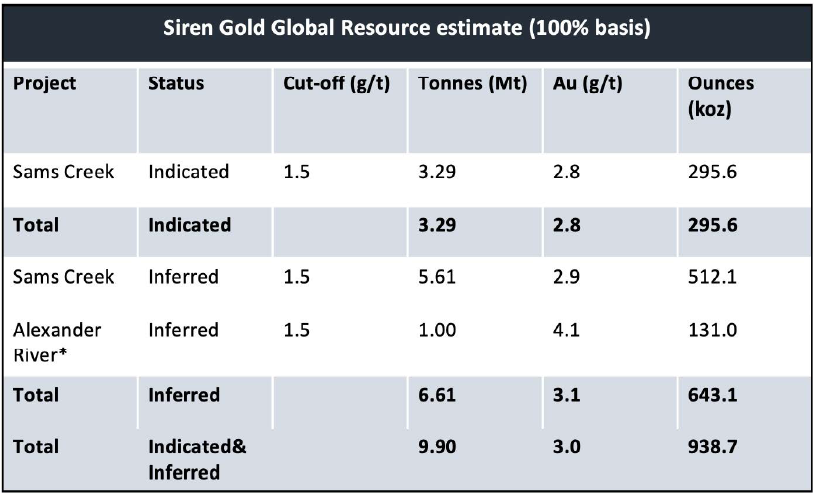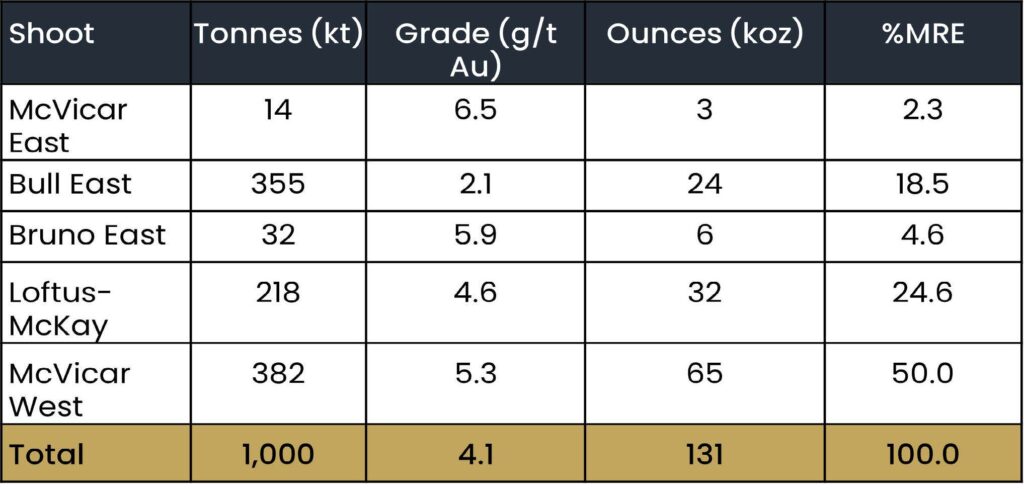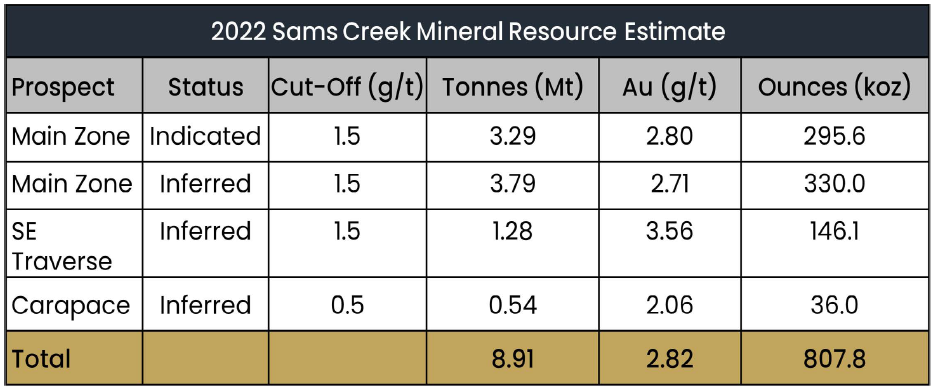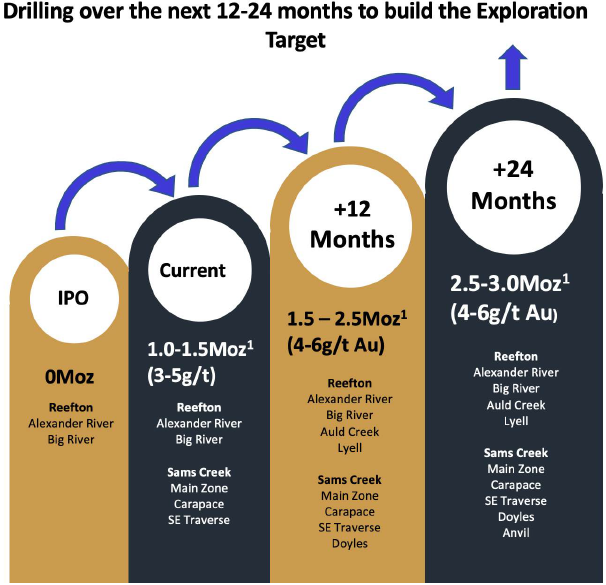Please start by giving readers some background to the company
Siren Gold Limited (ASX: SNG) listed on the ASX in October 2020 raising A$10m at $0.25 per share. The listing was based on advanced exploration projects at Alexander River and Big River and grass roots projects at Reefton South and Lyell, located in the South Island of New Zealand.
Siren has a dominant 1,073km2 tenement package with numerous high-grade gold mines in the Reefton and Lyell Goldfields and the Sams Creek porphyry dyke. These mining districts has a historical gold production of over 2Moz @ 17g/t Au with 268Koz @ 25.6g/t Au recovered from Sirens 100% owned tenements.
Since listing siren has drilled 146 diamond drillholes for a total of 27,000m and has completed regional mapping, soil geochemistry, geophysical surveys and a Maiden Mineral Resource Estimate (MRE) at Alexander River. Siren purchased the Sams Creek project for A$250k in November 2022 and completed an updated mineral resource based on a potential underground mining operation.
Siren now has a Global Indicated and Inferred MRE of 939Koz @ 3g/t Au at a 1.5g/t cut-off from the Sams Creek and Alexander River projects, with advanced exploration at Big River (high-grade gold), Auld Creek (high-grade gold and stibnite), and Lyell (high-grade gold) projects.
Siren’s Reefton, Lyell and Sams Creek tenements are completely under-explored with the potential to add significant additional new gold and stibnite resources with continued exploration.

Your operations are focused on the high-grade Reefton Goldfield and Sams Creek project in New Zealand, and are spread over a number of projects including Alexander River, Big River, Auld Creek, Lyell, and Sams Creek. Please can you give us a brief overview of each property?
The Reefton Goldfield was discovered in 1866 and produced +2Moz of gold at an average recovered grade of 16g/t from 84 historic mines. Most underground mining ceased by 1942, with the famous Blackwater mine closing in 1951 when the shaft failed after producing ~740Koz of gold down to 710m below surface. Federation Mining Limited is currently developing a 3.2km twin declines to intersect below the historic mine and is planning to extract over 700Koz of gold down to 1,500m below surface.
Siren holds a large, strategic package of tenements in the Reefton, Lyell, and Sams Creek Goldfields in the South Island of New Zealand. Western New Zealand was originally part the Lachlan Fold Belt that contains the orogenic gold deposits like Bendigo, Ballarat, Fosterville, and Costerfield, and porphyry copper-gold deposits like Cadia and Ridgeway.
There are two distinctive sub-types of orogenic gold mineralization in Victoria. The deeper (6-12km) mesothermal deposits that formed almost all the significant gold deposits in the Bendigo and Stawell zones and the shallower (<6km) epizonal gold and stibnite deposits in the Melbourne zone and eastern Bendigo zone including Fosterville and Costerfield mines. The latter gold mineralizing event in Victoria is characterized by arsenopyrite/pyrite-hosted refractory gold and stibnite associated gold which is very similar to the Reefton and Lyell mineralization.
Alexander River
The Alexander mineralization outcrops for over 1.2km (Figure 1) and comprises high-grade quartz reefs and disseminated mineralization. Surface trenching and channel sampling shows that the mineralization ranges from 2-15m thick, with an average thickness and grade of 4m @ 8g/t Au. Surface sampling identified four mineralized shoots, named Bull, McVicar, Bruno, and Loftus-McKay. Only the McVicar East Shoot was mined to any extent, with the shallow plunging shoot mined to 250m below surface, extracting 41koz at an average recovered grade of 26g/t Au before the mine closed in 1942.
The mineralized shoots comprise both quartz reef and disseminated acicular arsenopyrite mineralization, with the gold grades in the disseminated mineralization often higher than in the quartz.
A maiden MRE was completed in July ’22 with an Inferred MRE was estimated at 1Mt @ 4.1g/t Au for 131Koz at a 1.5g/t cut-off and 35g/t Au top-cap.

Big River
The Big River project lies 15km south-east of Reefton and includes the historic Big River Mine, which produced ~136,000oz of gold at an average recovered grade of 34g/t between 1880 and 1942 down to 550m. Four main ore shoots were mined (Shoots 1-4) with two potential unmined shoots; the A2 and Prima Donna, located east and west of the Big River mine. The A2 shoot, Big River Mine, and Prima Donna shoot combined cover a strike length of around 500m, which is overlaid by anomalous gold and arsenic soil geochemistry.
Diamond drilling was focused on Shoots 4 and A2. Drillhole results that intersected Shoot 4 include BR03 (2m @ 12.1g/t Au), BR04 (4m @ 4.4g/t Au from 128m and 6.6m @ 21.4g/t Au from 136m), BR09 (3m @ 18.5g/t Au from 147m and 4m @ 7.8g/t Au from 158m), BR12 (3m @ 5.4g/t Au from 170m and 3m @ 2.0g/t Au from 205m), BR27 (6m @ 5.1g/t Au), BR34 (5.9m @ 4.1g/t Au) and BR35 (6.3m @ 3.4g/t Au from 374.8m).
Diamond holes drilled into the A2 Shoot include 5.0m @ 4.2g/t Au from 24m, 3.4m @ 2.5g/t Au from 41m, and 5.2m @ 6.3g/t Au from 213m.
Siren has estimated an Exploration Target of between 100Koz and 125Koz at a gold grade between 7-9g/t Au for Shoot 4, based on existing drillholes. With additional drilling, similar exploration targets could potentially be estimated on the other shoots. The company considers Big River has upside potential of 250Koz to 500Koz.
Mapping has confirmed that the Sunderland Anticline that hosts the Big River mine extends for a further 5km to the south where it is cut off by younger granite intrusion. Anomalous arsenic and gold soil geochemistry extends along its length is only 4km east of the historic Blackwater mine that produced 740Koz at an average grade of 14.2g/t Au.
Auld Creek
The Auld Creek Prospect is contained within Siren’s Golden Point exploration permit and is situated between the highly productive Globe Progress mine, which historically produced 418Koz @ 12.2g/t Au, and the Crushington group of mines that produced 515Koz @ 16.3g/t Au. More recently OceanaGold Limited (OGL) mined an open pit and extracted an additional 600Koz of gold from lower grade remnant mineralization around the historic Globe Progress mine.
The Auld Creek mineralization extends for over 2km and appears to represent a block that was potentially offset to the west, along north-east to south-east trending faults between Globe Progress and Crushington. Auld Creek epizonal mineralization contains high grade gold and massive stibnite veins similar to the Costerfield and Fosterville mines in Victoria, Eastern Australia.

Trench results include:
- 6.0m @ 8.9g/t Au, 4.4% Sb for 15.8g/t AuEq in the Fraternal Shoot
- 2.0m @ 14.0g/t Au, 13.0% Sb for 34.6g/t AuEq in the Fraternal Shoot
- 8.8m @ 2.8g/t Au, 0.24% Sb for 3.3g/t AuEq in the Fraternal Shoot
- 4.0m @ 4.4g/t Au, 0.36% Sb for 4.6g/t AuEq in the Bonanza North Shoot
- 14.0m @ 2.0g/t Au, 0.8% Sb for 3.3g/t AuEq in the Bonanza Shoot
Diamond drillhole results in the Fraternal Shoot include true thicknesses of:
- 4.5m @ 3.02g/t Au, 3.2% Sb for 8.1g/t AuEq
- 3.0m @ 4.14g/t Au, 4.1% Sb for 10.6g/t AuEq
- 12.0m @ 4.11g/t Au, 2.9% Sb for 8.7g/t AuEq
The Bonanza and Fraternal North shoots have not been drilled.

Lyell
The Lyell gold soil anomaly extends for 4km north-west from the Alpine United Mine that produced ~80Koz of gold at an average recovered grade of ~17g/t between 1874 and closing in 1912. The gold soil anomaly contains four high grade areas; Alpine United, Break of Day, Mt Lyell, and Mt Lyell North. Work to date has focused on trenching the 1km long Mt Lyell North prospect. No drilling has been undertaken.
Trench results include:
- 7.0m @ 13.8g/t Au
- 8.0m @ 6.3g/t Au
Siren has discovered an outcropping quartz reef with significant visible gold in the north-west end of the Mt Lyell soil anomaly. The reef is surrounded by disseminated acicular arsenopyrite for a total thickness of approximately 2m, with results pending.
Sams Creek
The Sams Creek porphyry dyke (SCD) is located 140km north-east of Reefton and 100km north-east of Lyell. The SCD is up to 60m thick, can be traced for over 7km along strike, has a vertical extent of at least 1km and is open at depth. Drilling to date has focused on a 1km section of the dyke from the south-east traverse to the Main Zone.
The Sams Creek MRE contains 807,772oz at 2.82g/t Au, representing a 37.4% increase in contained ounces and a 16% increase in grade from the previous estimate at a 1.5g/t Au cut-off. At a higher cut-off of 1.85g/t Au, the MRE contains 7.07Mt grading 3.10g/t Au for 705,729oz of contained gold.
The SCD is open in all directions and has significant potential for increased gold resources from additional exploration drilling. The new MRE supports Siren’s strategy to develop a large tonnage, bulk mechanized underground mining operation.
What are some of the advantages to exploring in New Zealand?
The country offers a stable political environment with a defined pathway for development and supportive regulators and local communities.
From an investor’s point of view, what makes Siren Gold an attractive prospect?
Siren has a large strategic tenement holding in a segment of the Lachlan Fold Belt now located in New Zealand when the Gondwana continent was split up around 80M years ago. The Reefton and Lyell goldfields contain epizonal mineralization similar to the Fosterville and Costerfield mines in Victoria while Sams Creek porphyry dyke has similarities with the porphyry deposits like Cadia and Ridgeway.
Siren has three main mineralization targets:
- High-grade gold at Alexander River (diamond drillhole intersection of 2.5m @ 358g/t Au and a Maiden MRE of 131Koz @ 4.1g/t Au), Big River (diamond drillhole intersections of 6.6m @ 21.4g/t Au, 3m @ 18.5g/t Au and 4m @ 7.8g/t Au) and Lyell (trench intersections of 7.0m @ 13.8g/t Au, and 8.0m @ 6.3g/t Au)
- High-grade gold and stibnite mineralization at Auld Creek (trench and drill hole intersections include: 6.0m @ 8.9g/t Au, 4.4% Sb for 15.8g/t AuEq, and 12.0m @ 4.11g/t Au, 2.9% Sb for 8.7g/t AuEq) and Langdons. These grades are similar to Costerfield mine MRE of 9.5g/t Au and 2.4% Sb for 13.2g/t AuEq
- Large 3g/t Au resource at the Sams Creek porphyry deposit (Inferred and Indicated resource of 807Koz at 2.82g/t Au only around 15% of the 7km long dyke drilled to date)
Siren has a global resource of 940Koz @ 3g/t Au targeting at 2-3Moz resource at 3-5g/t Au.
What’s next on the horizon for your operations this and next year?
Siren’s strategy is to grow its Exploration Targets organically with continued drill-focused exploration on the company’s key projects over the next 24 months. Siren plans to commence drilling at Auld Creek, Lyell, and Sams Creek projects in the next six months.
The pathway to a multi-million-ounce exploration target is shown in Figure 4. (See previous page.)
Note 1: The potential quantity and grade of this Exploration Target is conceptual in nature as there has been insufficient exploration to estimate a Mineral Resource and it is uncertain if further exploration will result in the estimation of a Mineral Resource.












